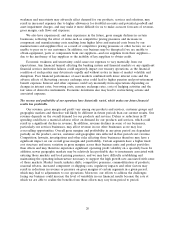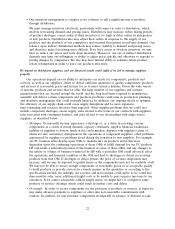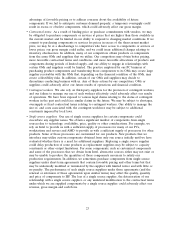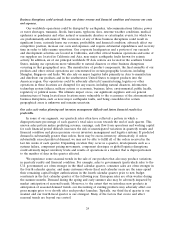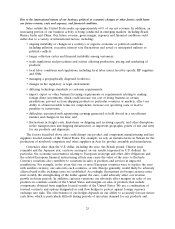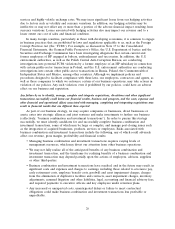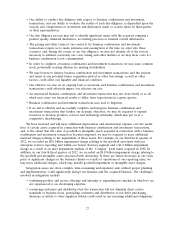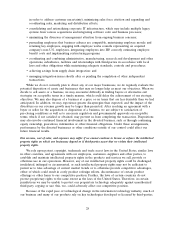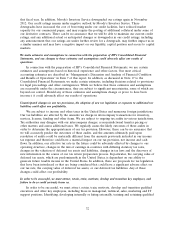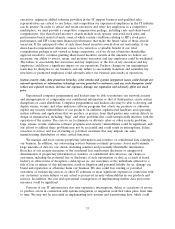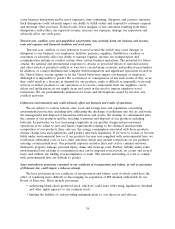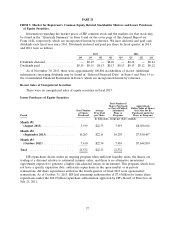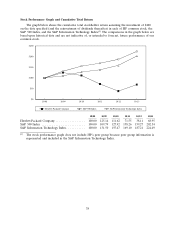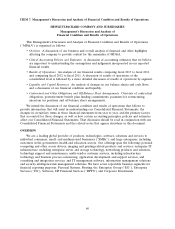HP 2013 Annual Report Download - page 38
Download and view the complete annual report
Please find page 38 of the 2013 HP annual report below. You can navigate through the pages in the report by either clicking on the pages listed below, or by using the keyword search tool below to find specific information within the annual report.those services. We may not be able to replace the revenue and earnings from any such lost
clients or reductions in services. In addition, our contracts may allow a client to terminate the
contract for convenience, and we may not be able to fully recover our investments in such
circumstances.
• The pricing and other terms of some of our IT services agreements, particularly our long-term
IT outsourcing services agreements, require us to make estimates and assumptions at the time
we enter into these contracts that could differ from actual results. Any increased or unexpected
costs or unanticipated delays in connection with the performance of these engagements,
including delays caused by factors outside our control, could make these agreements less
profitable or unprofitable, which could have an adverse effect on the profit margin of our IT
services business.
• Some of our IT services agreements require significant investment in the early stages that is
expected to be recovered through billings over the life of the agreement. These agreements
often involve the construction of new IT systems and communications networks and the
development and deployment of new technologies. Substantial performance risk exists in each
agreement with these characteristics, and some or all elements of service delivery under these
agreements are dependent upon successful completion of the development, construction and
deployment phases. Any failure to perform satisfactorily under these agreements may expose us
to legal liability, result in the loss of customers and harm our reputation, which could decrease
the revenues and profitability of our IT services business.
• Some of our outsourcing services agreements contain pricing provisions that permit a client to
request a benchmark study by a mutually acceptable third-party. The benchmarking process
typically compares the contractual price of our services against the price of similar services
offered by other specified providers in a peer comparison group, subject to agreed upon
adjustment and normalization factors. Generally, if the benchmarking study shows that our
pricing has a difference outside a specified range, and the difference is not due to the unique
requirements of the client, then the parties will negotiate in good faith any appropriate
adjustments to the pricing. This may result in the reduction of our rates for the benchmarked
services performed after the implementation of those pricing adjustments, which could decrease
the cash flows of our IT services business.
• If we do not hire, train, motivate and effectively utilize employees with the right mix of skills
and experience in the right geographic regions to meet the needs of our services clients, our
profitably could suffer. For example, if our employee utilization rate is too low, our profitability
and the level of engagement of our employees could suffer. If that utilization rate is too high, it
could have an adverse effect on employee engagement and attrition and the quality of the work
performed, as well as our ability to staff projects. If we are unable to hire and retain a sufficient
number of employees with the skills or backgrounds to meet current demand, we might need to
redeploy existing personnel, increase our reliance on subcontractors or increase employee
compensation levels, all of which could also negatively affect our profitability. In addition, if we
have more employees than we need with certain skill sets or in certain geographies, we may
incur increased costs as we work to rebalance our supply of skills and resources with client
demand in those geographies.
Failure to comply with our customer contracts or government contracting regulations could adversely affect
our revenue and results of operations.
Our contracts with our customers may include unique and specialized performance requirements.
In particular, our contracts with federal, state, provincial and local governmental customers are subject
to various procurement regulations, contract provisions and other requirements relating to their
30


